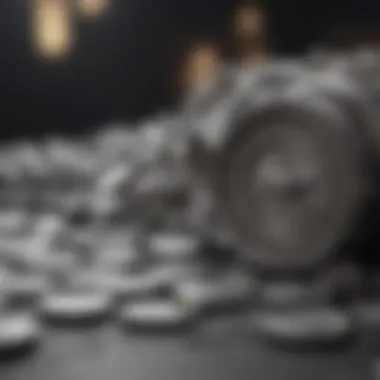Historical Trends and Influences on Silver Prices


Intro
Understanding the fluctuations in silver prices over the past century is not just an exercise in history; it is a doorway into the wider world of economics, trade, and investment strategies. Silver, a metal often overshadowed by gold, holds its unique significance, functioning as both an industrial commodity and a store of value. As we trace the trajectory of silver prices from 1900 to the present day, we can glean insights that are not only numerically significant but also rich in context, story, and applicability to modern investors.
From the industrial boom of the early 20th century to the financial crises of today, various external factors have shaped silver's valuation. In this analysis, we aim to unravel the intricate threads that intertwine the market dynamics of silver with historical events, technological advancements, and investor sentiments.
This article will provide detailed discussions on current market sentiment surrounding silver, offer a closer look at significant indices, and analyze economic indicators that affect the silver market landscape. For both novice and seasoned investors, our comprehensive investigation will lay the groundwork for a deeper understanding of why silver continues to be an essential part of the investment portfolio.
Market Overview
Current Market Sentiment
The sentiment surrounding silver remains a blend of cautious optimism and strategic positioning. Investors often perceive silver as a hedge against inflation and economic uncertainty. Recently, heightened volatility in equity markets has prompted a renewed interest in precious metals, reflecting a flight to safety. The market sentiment can vary, however, based on both geopolitical events and internal market changes.
Major Indices Performance
To make sense of silver’s price movements, it is essential to consider the performance of major indices such as the S&P 500 and commodity-focused indices. A declining stock market often correlates with rising silver prices, as traders seek refuge in tangible assets. In the wake of recent economic events, these indices have exhibited significant fluctuations, which in turn influence silver’s pricing.
Economic Indicators Analysis
Several economic indicators lead the charge in explaining silver price changes. For instance, interest rates, inflation rates, and industrial demand all play pivotal roles. Inflation typically drives demand for silver, causing price increases.
The following are some relevant indicators to keep an eye on:
- Inflation Rate: When inflation surges, precious metals like silver tend to see price jumps.
- U.S. Dollar Strength: A weak dollar often leads to higher silver prices as it becomes cheaper for foreign buyers.
- Industrial Demand: Emerging technologies, including renewable energy sources and electronics, bolster demand for silver.
"The patterns in history teach us that silver can react sharply in times of economic distress, often contrary to what investors intuitively expect."
Overview of Silver as an Investment
Understanding the position of silver in the investment world is key to grasping its past and future price movements. Silver has been cherished for not just its aesthetic qualities but for its functional value across various sectors—be it jewelry, electronics, or as a global currency in times past. As we look back, the significance of silver emerges not only as a mere commodity but as a vital player in the economic theater.
In the context of today’s market, silver stands out as a versatile and relatively accessible asset. While some may argue that gold takes the spotlight, silver has its own charm and compelling role. Given its lower price point compared to gold, silver is often considered a gateway investment for newcomers to the precious metals market. It allows investors to dip their toes into commodity investment without breaking the bank. Furthermore, silver's dual role—as both an industrial metal and a store of value—offers unique advantages and complexities in building a diversified investment portfolio.
The current climate around silver investments has evolved, attracting various stakeholders from different financial backgrounds. In a world where economic uncertainties loom large, the potential of silver shines brighter. It serves as a hedge against inflation and currency devaluation, much akin to what you get with gold—a silver lining for many investors seeking security.
The intricate dance between silver’s historical significance and its contemporary relevance makes it an exceptional subject of study. Investors must consider factors such as economic cycles, geopolitical tensions, and technological advancements that influence silver’s behavior in the market.
"Silver has not just been an asset; it has been a reflection of our society's aspirations and economic shifts throughout history."
Among the benefits of investing in silver are the following:
- Accessibility: Lower prices make it easier for entry-level investors.
- Diversification: A strong addition to portfolios seeking balance.
- Hedge against inflation: Provides a shield in unstable economic climates.
With these points in mind, the exploration of silver's history and modern investment trends becomes not just an academic exercise, but a practical guide for those navigating the financial waters.
Historical Significance of Silver
Delving into silver's history reveals its role as a cornerstone of civilization. Silver was used in ancient coins and transactions, dating back thousands of years. Its intrinsic qualities—the lustrous sheen and malleability—made it a desirable medium of exchange and a standard for value. From the Roman Empire to the medieval kingdoms, silver coins set the price of goods and services and served as a testament to economic prosperity.
During the 19th century, the discovery of new silver mines in places like Nevada redefined its significance in the global economy. The drive for silver sparked mining booms and economic expansion, particularly in the Western United States. The phrase "the silver rush" encapsulates an era where silver not only fueled local economies but also shaped national policies, influencing decisions about currency standards that would resonate for decades.
This historical context sets the stage for silver's modern applications and its unique position as both a precious metal and an essential industrial component.
Silver in Modern Investments
Fast-forward to today, silver has transformed into a significant investment asset that attracts traders and investors alike. In a world increasingly focused on technology and sustainable practices, silver's role extends beyond traditional uses. It’s heavily utilized in solar panels, batteries, and various electronics—making it not just a relic of history, but a pivotal part of industries driving the future.
The financial instruments connected to silver have also evolved. Investors can now access silver-backed exchange traded funds (ETFs), mining stocks, and physical silver options, broadening the avenues available for investment. Such innovations have made silver more accessible, aligning with modern investment strategies.
In essence, silver remains a potent asset, reflecting both market sentiments and consumer behavior. By examining the interplay of its historical significance and modern relevance, investors can better navigate the complexities of the silver market, making informed decisions that echo beyond immediate trends.
Economic Context of Silver Prices
Understanding the economic context of silver prices is crucial for comprehending the broader narrative of its investment value over time. Silver, often considered a precious metal alongside gold, is influenced by a myriad of economic events, market dynamics, and changes in consumer behavior. These factors create a web of interactions that affect how silver is priced, and unraveling them can offer investors insights that refine their strategies.
One aspect that stands out in the economic context is the impact of major historical events—these shape the market in ways both expected and unexpected. For instance, during periods of economic upheaval, silver tends to perform differently compared to stable times. Knowing this helps in developing informed perspectives on when to enter or exit the silver market.


Key Economic Events Impacting Silver Prices
World Wars
The two World Wars were defining moments in global history, and their imprint on silver prices is noteworthy. The first World War, which erupted in 1914, caused governments to mobilize resources, leading to increased silver mining to fund military operations. This demand pushed prices up, causing fluctuations that investors had to navigate with care.
What's particularly striking is that during the second World War, silver's dual role as a currency and an industrial metal took center stage. The U.S. wartime economy required significant silver for manufacturing, amplifying its demand even further. Not only did this increase prices, making silver a less accessible commodity for the average investor, but it also underscored the metal's strategic significance in wartime.
Great Depression
The Great Depression marked an unprecedented economic downturn from 1929 to the late 1930s. A significant characteristic of this era was the collapse of stock markets and a severe constriction of liquidity. Investors often flocked to silver as a hedge against the plummeting stock prices—suddenly, silver took on the role of a safe haven.
While it offered some protection, silver prices were also subject to government interventions, such as the introduction of policies aimed at regulating and stabilizing the market. These regulatory frameworks nurtured the narrative of silver as both a commodity and a currency. Thus, the Great Depression is a landmark event that showcases the duality of silver’s role in times of financial strife.
Institutional Changes
Institutional changes throughout the decades also played a pivotal role in shaping silver prices. For example, the introduction of the Silver Purchase Act in 1934 set a precedence whereby the U.S. government began buying silver to support its value. Such institutional backing can make silver a more attractive investment, breathing life into its market performance.
Additionally, the establishment and later the rise of the Commodity Futures Trading Commission brought transparency to silver trading. This encouraged investor participation, making it a more vibrant market. With these changes established, the institutional factors created a framework within which silver prices could be better anticipated, thereby drawing in a wider array of investors.
The Role of Supply and Demand
As with other commodities, supply and demand plays a crucial role in determining silver prices, and various factors contribute to this balance. Understanding these dynamics gives investors an edge in predicting market movements.
Mining Production
Mining production is foundational in establishing the supply side of silver prices. Throughout the 20th century, major silver mining operations in countries like Mexico, Peru, and Canada have significantly impacted market availability. Fluctuations in mining output—whether due to technological advancements or production halts—directly affect silver prices.
A unique feature of mining production is its susceptibility to external factors, such as geopolitical instability or natural disasters. These unpredictable elements can lead to price volatility, making this aspect exceptionally significant for any investor looking at the silver market.
Industrial Demand
Industrial demand for silver has seen considerable changes over the decades, particularly with silver finding applications in electronics, photovoltaics, and medicine. This demand adds a layer of complexity to price determinations, as it can be volatile based on technological innovations and market needs.
A notable characteristic of industrial demand is its cyclical nature; as technologies emerge or shift, the demand for silver can either spike or dip. This makes it an intriguing aspect for investors due to the continual adaptation in its usage, giving insights into future price trends.
Investment Demand
The demand for silver as an investment is another critical component of the overall economic landscape. Investors often turn to silver during times of uncertainty as it acts as a hedge against inflation, much like gold.
Investment demand is characterized by physical silver purchases and exchange-traded funds (ETFs). With the rise of various financial instruments linked to silver, understanding how investment demand shifts can assist investors in making timely decisions that align with their portfolio strategies.
In summary, the economic context surrounding silver prices reveals complex interdependencies. From world-altering events to evolving market dynamics, several elements converge to dictate the value of silver on any given day. Understanding every facet—from institutional influences to shifts in supply and demand—allows investors and analysts to paint a complete picture of silver's journey from 1900 to the present.
Decade-by-Decade Analysis of Silver Prices
Understanding the evolution of silver prices over the decades provides invaluable insights into the market’s dynamics. Each decade is marked by unique economic events, technological advancements, and shifts in consumer demand. This section not only contextualizes price changes but also helps investors grasp the factors influencing silver at different times, thereby allowing for more informed decisions regarding future investments.
Early Twentieth Century
Silver Prices in the 1900s
In the early part of the twentieth century, silver prices experienced significant fluctuations, largely in response to global economic conditions and changing monetary policies. Price averages hovered around $0.50 per ounce at the start of the century. This period saw silver marketed as a staple for coinage and industry, which gave it a strong foundational value. Unlike today, when silver often serves as an investment vehicle, silver in the 1900s was primarily practical, supporting economic activities.
Its tangible nature was attractive to many investors who viewed it as a safe harbor against currency instability.
Factors Contributing to Price Variations
Several causes played roles in the ups and downs of silver prices during this time. Industrial demand surged, particularly in electrical applications as inventions and innovations began to rise. Moreover, dramatic events such as World War I started impacting supply chains and causing market uncertainty. Changes in mining practices and discoveries of deposits paved the way for increased production, which often flooded the market, driving prices down during certain periods. These factors underscore the complexity behind silver's pricing, presenting both benefits and risks for potential investors.
The 1920s and 1930s
Impact of the Great Depression
The Great Depression undoubtedly cast a long shadow on silver prices. As the global economy crumbled in the late 1920s, silver prices plummeted. From baseline prices around $1 per ounce in 1920, values dropped dramatically, sometimes to less than $0.25 per ounce. This drastic decline was rooted in deflationary pressures and reduced industrial demand, as many factories closed and consumer spending faltered. During this harsh era, the role of silver shifted, leading many investors to question whether it was still a viable safe haven.
Government Regulations
During the 1930s, government policies began to reshape the landscape of silver trading. In the U.S., the government enacted the Silver Purchase Act in 1934, which mandated that the Treasury began acquiring large quantities of silver. This law effectively aimed to stabilize prices and support both the mining industry and the economy as a whole. However, the nuances introduced by government regulations also meant that investors had to navigate a more manipulated market. This period showcased how external influences could sway the intrinsic value of silver, sometimes with mixed outcomes.


The Mid-Twentieth Century
Post-War Economic Growth
The aftermath of World War II played a pivotal role in revitalizing the silver market. As economies began to recover, silver found its footing once again. Prices began to rise consistently, reaching close to $2.50 per ounce by the late 1940s. Rising industrial demand, particularly in electronics and emerging technologies, contributed to this growth. Silver emerged not just as a commodity, but as an integral part of post-war development, further bolstered by the global economic boom.
Investors found renewed confidence as the value of silver seemed increasingly stable within a growing economy.
Technological Advancements
Technological innovations during this time also drove silver demand. The boom in consumer electronics and photographic film further fueled the precious metal's value. However, it also meant that supply needed to keep pace as new production methods emerged, sometimes leading to excesses that would impact future price stability. Understanding these evolutions is crucial in dissecting how silver maintained relevance amidst rapidly changing markets.
Silver in the 1970s
Inflation and Commodities
The 1970s was marked by rampant inflation and a global commodities boom, which drastically affected silver prices. Caught in the throes of economic volatility, silver saw prices skyrocket, reaching an astonishing $50 per ounce by 1980. Inflation inherently drove investors toward commodities like silver, which were often seen as a buffer against the deteriorating purchasing power of money.
This decade starkly illustrated the relationship between macroeconomic indicators and silver valuation, proving invaluable lessons for investors.
Speculative Trading
In parallel, the rise of speculative trading strategies changed how silver was viewed. Tales of individuals striking it rich flooded the media, luring many into the silver market. However, such speculation often led to erratic price swings, which could serve as both an opportunity and a warning for seasoned traders. The ephemeral highs destabilized the market, drawing scrutiny and changing perceptions about silver's role as a safe investment.
The 1980s and 1990s
Market Stabilization
As the dust settled from the inflationary chaos of the 1970s, market stabilization took center stage in the 1980s. Silver prices oscillated significantly but landed around $5 per ounce by the end of the decade. Governments implemented more consistent economic policies, which stabilized purchasing power and reduced extreme volatility. This normalization, however, had its pros and cons, maintaining the allure of silver yet disengaging some speculative investors.
Emergence of ETFs
The launch of Exchange-Traded Funds in the late 1990s drastically changed investing in silver. Investors could now trade silver more easily without holding the physical metal. This convenience enhanced accessibility and liquidity in the market, attracting both novice and experienced investors. While overall market volumes increased, this revolution ushered in new dynamics around price fluctuations, prompting individuals to rethink their strategies.
The Early Twenty-First Century
Price Volatility
Entering the 21st century, silver re-entered a phase of significant price volatility, influenced by a myriad of factors—global economics, currency fluctuations, and trading psychology. During this period, prices often danced between highs and lows, reaching peaks of over $40 before dropping to more stable levels. The driving reason for such drastic changes relied both on external market pressures and internal investor sentiment.
For investors, this highlighted the importance of understanding both market fundamentals and psychological elements that push buyers and sellers.
Global Financial Crises
The financial turmoil of 2008 reminded many of silver’s historical value as an economic hedge. Silver prices rallied amidst economic uncertainty, showcasing characteristics of a safe-haven asset. The global financial crisis reaffirmed the importance of silver in diversified portfolios, prompting shifts in investment approaches as many sought stability.
Recent Trends in Silver Prices
Market Recovery Post-COVID
After the pandemic shook the world in 2020, markets began to recover with silver leading the charge. Prices soared back to life as governments unleashed massive economic relief packages, injecting liquidity into the market. Special attention turned to silver as industries reopened and green technologies escalated, setting a foundation for strong demand. This resurgence marked silver’s resilience amidst adversity, drawing interest from many investors encouraged by its forecasted growth potential.
Sustainability and Green Technologies
In this era of sustainability, silver’s role has expanded dramatically. With the rise of green technologies, particularly in solar energy and electric vehicles, silver is now seen as an essential element for a sustainable future. This new demand signals not just a continuation of silver's legacy, but a promising opportunity for investors looking to align portfolios with the needs of the greener economy. It presents a critical juncture for potential investors to consider shifts toward sustainable investment strategies.
Understanding these trends equips investors with a comprehensive perspective on silver’s historical trajectory, alongside insights into its future potential.
Influence of External Factors on Silver Prices
Understanding how external factors influence the prices of silver is essential for investors, economists, and historians alike. This section delves into how geopolitical events, technological innovations, and monetary policy shape the silver market over the decades. These factors act as a barometer not only for silver itself but also for the broader economic landscape. Grasping these influences can better inform investment strategies and enhance comprehension of market dynamics.
Geopolitical Events
Trade Wars
The impact of trade wars on silver prices can't be understated. When tariffs and trade barriers come into play, the demand we see can be drastically altered. For example, in the recent US-China trade tensions, the uncertainty created shifted investor focus towards precious metals, including silver. This scenario became a protective shield, driving prices upward.
A key characteristic of trade wars is that they lead to commodity volatility. It’s widely recognized that such confrontations can trigger widespread anxiety among investors, making precious metals like silver a more appealing option for those seeking shelter from market storms. This makes it a beneficial focus for our analysis, as it highlights how external factors can not only alter market conditions but also investor behavior.
The unique feature of trade wars is they foster an environment rife with speculation and uncertainty, where investors may flock to silver, pushing prices higher. However, this also has its disadvantages, as such price increases may not be sustainable once tensions ease or resolve.
Political Instability


Political instability is another critical external factor. Countries experiencing upheaval often see spikes in silver prices as citizens look for a safe haven to protect their wealth. For instance, during the Arab Spring, many turned to silver and gold to safeguard their investments, as uncertainty loomed.
A significant characteristic here is that political instability often incites fear, leading to hoarding behaviors among investors. This is important because it brings to light how quickly sentiment can swing and thus affect silver prices dramatically. Analyzing political instability lends crucial insights into market reactions during turbulent times.
The unique feature of political turmoil is that it can cause liquidity issues in the market. People tend to hold onto their silver assets rather than sell, creating tight supply. This can fuel prices further, presenting both an advantage and disadvantage – while prices may rise during instability, long-term investments can be jeopardized by unpredictable political shifts.
Technological Innovations
Emergence of New Industries
The emergence of new industries has significantly influenced silver prices, notably in the fields of electronics and renewable energy. Silver's unique properties make it an essential component in electronics; this demand generates consistent upward pressure on silver prices.
A key characteristic of this phenomenon is the ongoing growth in technology sectors that rely heavily on silver. As these industries expand, the demand for silver increases, showcasing how innovations can create market opportunities. This factor is beneficial for our study as it reflects shifts in industrial needs and how they correlate to silver investment viability.
The unique aspect of new industries is their unpredictability. Emerging technologies can drive silver demand to unforeseen heights or, conversely, lead to over-supply scenarios if market-driven dynamics take a wrong turn. This illustrates a precarious balance between growth potential and market stability.
Recycling Technologies
Recycling technologies present another layer of complexity in the silver market. As industries adopt more sustainable practices, the recycling of silver becomes a key factor in its overall supply and price dynamics. This can alter traditional mining narratives, affecting long-term pricing strategies and market perceptions.
A defining characteristic of recycling technologies is that they promote sustainability, making silver investment more appealing to environmentally conscious investors. This is an important element in our analysis, especially as we witness an increasing global shift towards sustainable practices.
The unique feature of recycling in silver markets is that it can lead to a more stable price environment in the long run; however, should recycling output grow significantly, it could cause an oversupply, dampening prices. Thus, the balancing act between recycled and newly mined silver remains a pivotal consideration.
Monetary Policy and Silver Prices
Monetary policy is perhaps the most potent external factor influencing silver prices. Central banks globally use interest rates and currency regulations to control inflation and stimulate economic growth. Changes in these policies can dramatically shift demand for precious metals.
When central banks lower interest rates, the opportunity cost of holding non-yielding assets like silver declines, leading to increased demand. Conversely, when rates rise, silver prices often tumble as investors seek higher yields elsewhere. Understanding monetary policy provides high-context insights into the oscillations of silver prices.
Overall, the factors discussed in this section illustrate the intricate interplay between silver prices and the external elements impacting them. By recognizing these dynamics, one can cultivate a more nuanced perspective on silver market trends.
Silver as a Hedge against Economic Uncertainty
Silver has long been viewed as a robust instrument for investors looking to safeguard their assets amidst economic fluctuations. Unlike the whims of stocks or the unpredictable nature of cryptocurrencies, silver has intrinsic value, rooted in both its industrial applications and traditional role as a store of value. The dynamics of supply, demand, and the broader economic context heavily influence its performance. More than just an artifact of wealth, silver can serve as a bulwark against the unpredictability of financial markets, offering peace of mind during turbulent times.
Understanding Safe-Haven Assets
Safe-haven assets are investments that investors flock to during periods of market volatility and economic distress. Silver fits snugly into this category. Its historical context as a tangible asset gives it a unique position in the investor psyche. While gold often takes the limelight, silver shouldn’t be neglected. It has distinct advantages:
- Affordable Entry Point: Silver is generally more accessible than gold due to its lower price per ounce, making it easier for new investors to accumulate.
- Industrial Demand: Beyond being a precious metal, silver's conductivity and antibacterial properties boost its demand in electronics, healthcare, and renewable energy fields, particularly solar energy.
- Market Correlation: Sometimes, silver prices might move inversely to the stock market. This means that when stocks take a nosedive, silver might rise, providing a cushion.
By understanding these facets, investors can appreciate why silver is often tucked away in investment portfolios as protection against a shaky economy.
Performance During Economic Downturns
Historically, during economic downturns, silver has held its ground relatively well. This resilience can often be observed through several key behaviors:
- Price Surge in Crisis Events: Notably, during the 2008 financial crisis, silver experienced a significant increase. Even though it dipped early in the crisis, it later surged as investors sought tangible assets.
- Increased Demand for Jewelry and Industrial Uses: In tough economic times, consumers will often shift purchasing preferences, investing in silver jewelry or electronics, which bolsters its demand.
- Flight from Currency Value: When confidence in fiat currencies wanes, as seen during inflationary periods, silver's allure as a tangible asset tends to grow.
"Silver acts as a shield against economic uncertainty, allowing investors to maintain a semblance of security in stormy financial seas."
In summary, silver's multifaceted appeal during economic uncertainty makes it a compelling addition to any investor's toolkit. Its historical precedence, combined with its tangible applications, positions it favorably for those looking to weather financial storms.
Future Perspectives on Silver Prices
The analysis of silver prices over more than a century offers a glimpse into the metal's historical significance and market behavior. Yet, as we look ahead, understanding future perspectives on silver requires digging deeper into various factors that may influence its value. Prospective investors must consider not only the economic landscape but also technological advancements, geopolitical shifts, and changing investment patterns. This section aims to shed light on where silver prices might head in the coming years and underscore the implications for investors.
Market Predictions
Forecasting silver prices isn't as straightforward as predicting the weather. Various elements come into play that can tilt the scales. Analysts today are watching several trends closely:
- Integration of Green Technologies: As the world shifts towards renewable energy, the demand for silver, particularly in solar panels, is on the rise. This can potentially drive prices upward.
- Economic Recovery Post-Pandemic: Countries are on a recovery path, and as economies stabilize, industrial demand for silver may rebound, influencing prices positively.
- Inflation Erosion: If inflation stays high, precious metals such as silver may regain their appeal as safe-haven assets, pushing prices higher.
Analysts project that in the next five years, silver could range between $20 and $35 an ounce, fluctuating based on the outlined factors. Investors are advised to build a robust strategy to navigate this predicted landscape.
"Market sentiment can often shift quicker than the tide. Keeping an eye on global events and technological advancements is essential for any serious investor."
Investment Strategies Moving Forward
Investment strategies concerning silver must adapt to changing market dynamics. Here are some potential strategies for investing in silver effectively:
- Diversification: Silver provides an excellent diversifying element in a portfolio. It reduces overall risk when combined with stocks and bonds.
- Physical vs. Paper Investments: Investors can choose between physical silver (like coins and bars) or paper investments (silver ETFs or mutual funds). Understanding the pros and cons of each will aid in decision-making.
- Long-term View: Short-term trading might be tempting, but patience can often lead to better returns. Silver has a history of bouncing back after downturns.
By employing these strategies, investors can better position themselves to not only withstand market fluctuations but potentially capitalize on them as well. Keeping abreast of market trends is just as crucial as crafting a strategy that aligns with personal financial goals.



